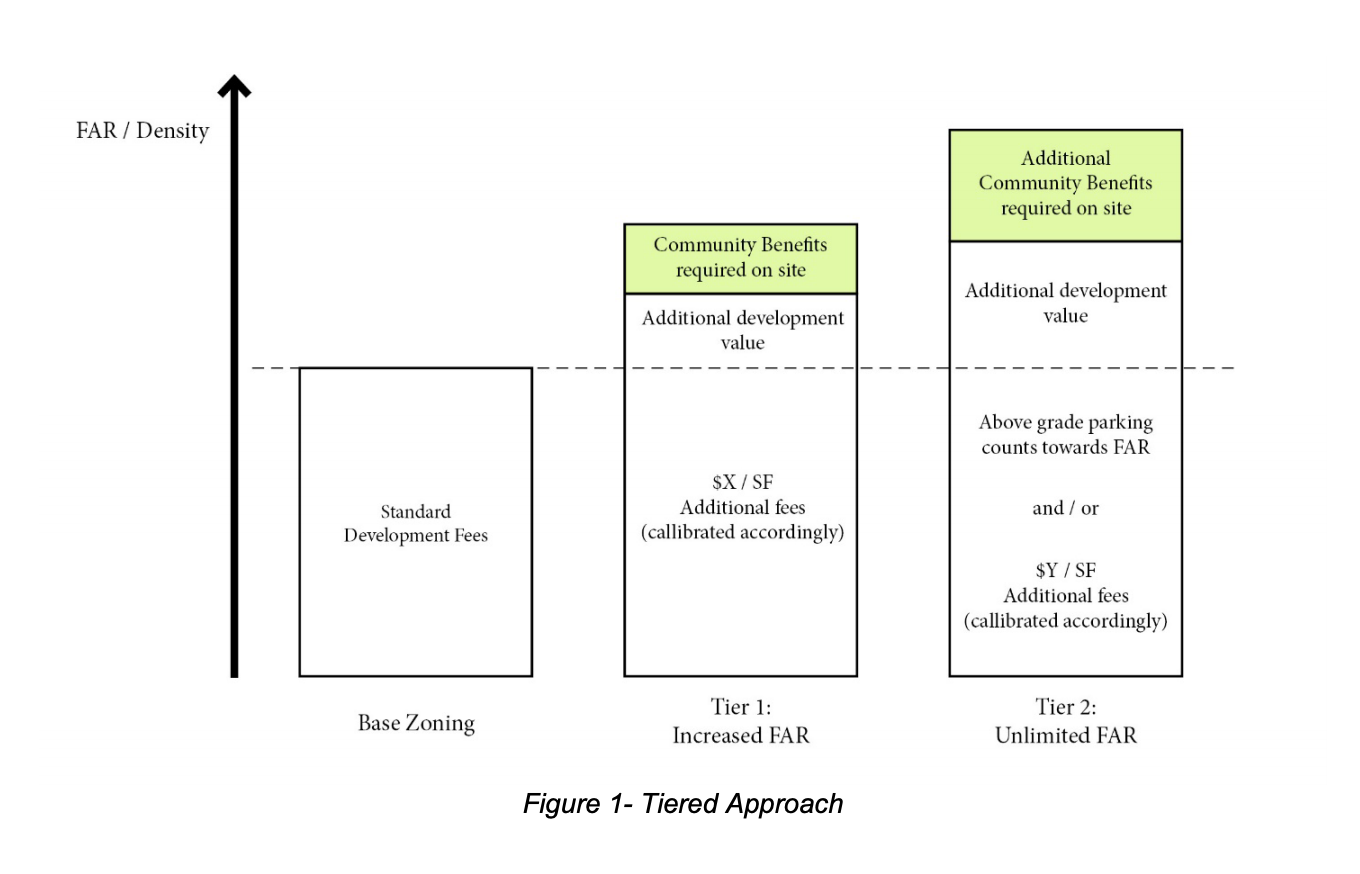Design Commission wants to remove downtown FAR caps, cut Council out of density bonus program
Monday, August 16, 2021 by
Jonathan Lee Following a City Council discussion earlier this year about updating the Downtown Density Bonus Program, the Design Commission last week recommended several changes for Council to mull, including removing Council’s discretion over allowing extra-dense towers and removing floor area ratio limits.
Council’s discussion and the commission’s recommendations centered around one aspect of the program: the fees required in lieu of on-site affordable housing, one of the several community benefits the program currently requires of developers in exchange for more floor area ratio (a measurement of density).
Council Member Kathie Tovo, who initiated Council’s discussion, called for higher fees and more community benefits. Tovo’s resolution, which Council passed in April, established interim fees, calibrated in 2019, to replace fees last calibrated in 2013. City staffers are expected to release up-to-date fees soon.
The resolution also began a conversation about what to do with extra-dense towers. Currently, if a developer proposes a building with less floor area ratio than the FAR limit (25:1 in most of downtown), the requirements for the program are straightforward, and Council doesn’t get involved. But if developers want more FAR, they have to ask Council first.
Though Council expects more benefits, developers are left to guess what will please Council. After three Rainey projects concurrently requested to exceed FAR caps, Tovo decided that Council must make these requirements clearer. “We’re applying an extremely outdated formula of benefits,” Tovo said in April, adding: “We are really leaving money on the table.”
The commission’s recommendations were split into two parts: how to collect benefits like affordable fees-in-lieu, and how to spend the fees.
The commission recommended collecting more fees and benefits, in line with Tovo’s thinking. Beyond that, however, the two visions diverge.
First, the commission wants Council out of the approval process. Tovo has said that while she wants to require additional community benefits from projects that exceed that cap, their approval would still be at Council’s discretion. The commission recommends a similar system – projects below a certain FAR must provide certain community benefits and projects above that must provide more – but removes Council’s “discretionary and unpredictable” role.
The diagram below further explains the commission’s “tiered approach”:

The commission opted not to recommend specific community benefits, leaving that up to Council, but did mention on-site affordable housing in residential buildings as a potential requirement.
The other drastic departure from Tovo’s vision is removing FAR caps for all of downtown. While the program lays out generous 25:1 FAR caps in most of downtown, some areas offer much less (15:1, 8:1, even 3:1). The commission’s recommendation would mean towers of any height and density could be built anywhere downtown if they comply with the reworked community benefits scheme.
This recommendation is likely to encounter strong pushback from some Council members – Tovo most of all, who has floated preventing developers from exceeding FAR caps at all and has sided with Rainey residents who complain that their neighborhood can’t handle more housing.
The commission, on the other hand, touted the benefits of high-density housing: “The Design Commission believes that additional density and supply of housing downtown is a community benefit in and of itself due to the need for housing and critical mass to support the viability of public transit.”
The commission also recommends spending fee revenue differently. Currently, the revenue only goes toward housing vouchers. The commission would like to see that money distributed more broadly, in particular to help create affordable housing. The recommendation mentioned giving money to city entities like the Austin Housing Finance Corporation and the Austin Economic Development Corporation, both of which play a role in creating affordable housing. These two departments seemed like “safe and obvious choices,” Chair David Carroll said, versus naming private-sector affordable housing developers. In the commission’s vision, the voucher program would still get roughly the same amount it does today, and the rest of the revenue would go elsewhere.
Photo made available through a Creative Commons license.
The Austin Monitor’s work is made possible by donations from the community. Though our reporting covers donors from time to time, we are careful to keep business and editorial efforts separate while maintaining transparency. A complete list of donors is available here, and our code of ethics is explained here.
You're a community leader
And we’re honored you look to us for serious, in-depth news. You know a strong community needs local and dedicated watchdog reporting. We’re here for you and that won’t change. Now will you take the powerful next step and support our nonprofit news organization?









